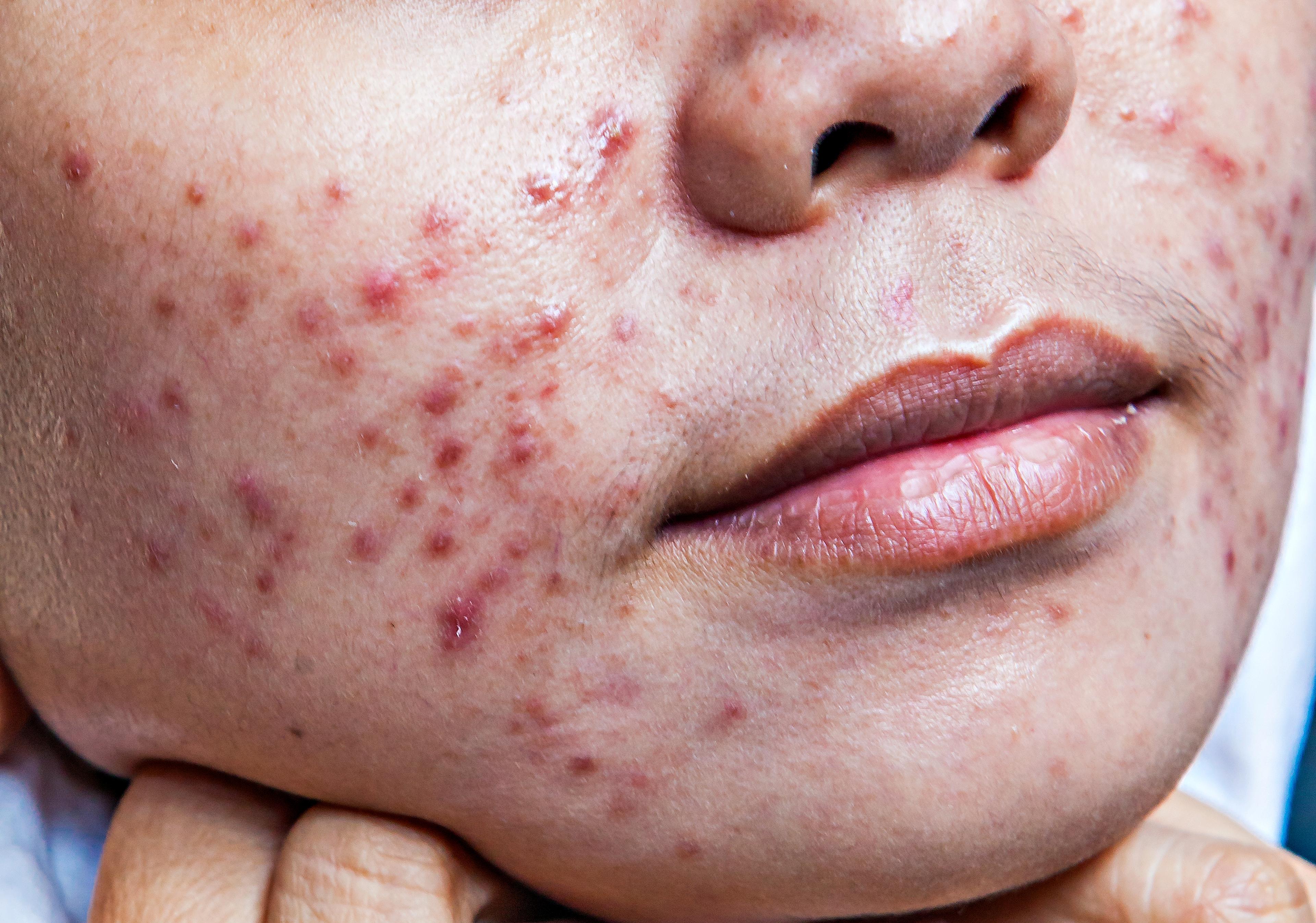We all have our own hang-ups about our skin. For some, it’s fine lines, for others, it’s large pores. But for many, it’s acne. In fact, according to the NHS, around 95% of people aged between 11 and 30 are affected by acne at some point. The most severe type is cystic acne, which can be not only painful but can significantly affect self confidence too. In this article, we speak to Shelley Folkes - NHS nurse and founder of The Glow Clinic Hereford - who shares her experience with cystic acne, and we also look at how to treat cystic acne effectively for great skin results.
Cystic Acne? Here's How to Treat It
What is cystic acne?
When you break it down, acne equals spots, and acne sufferers can experience a range of them - from blackheads, whiteheads, pustules and papules, to nodules and cysts. As the name suggests, cystic acne is presented as angry cysts on the face, back or chest (or sometimes all of these areas). And these cysts, which are similar in appearance to boils, go deep within the skin, initially filling with blood which later turns to puss. If you have cystic acne, I don't need to tell you how painful this can be! It’s really important, though, not to pick at or squeeze cysts, as this will cause more damage to your skin.
With cystic acne often comes scarring, and this is due to the fact that, sometimes, cysts rupture under the skin, leaving scars that are long-lasting. However, there are some treatments that can help improve the appearance of acne scars, which I’ll cover in a mo…
What causes cystic acne?
Acne occurs when the body produces too much oil (sebum) which then, along with dead skin cells, blocks hair follicles. It can be down to several things... usually, hormones or hormonal changes, so, for example, puberty, pregnancy, periods, starting the pill, or menopause. Or it can be as a result of polycystic ovary syndrome (PCOS). But then, there’s also genetics. If your parents had acne, you may well too. And it can feel pretty unfair when it does strike! When it comes to cystic acne, bacteria on the skin can get into the hair follicle and create cysts and nodules, which can be really painful and difficult to look after. But there are ways to treat it, which we'll move on to soon.
A skin pro's cystic acne experience
I recently spoke to the lovely Shelley Folkes at The Glow Clinic Hereford, who told me all about her experience with cystic acne, which started when she was 21 - around the time she started taking a new hormonal contraception. She was so passionate about the skin concern that she became an aesthetic practitioner to treat others living with it. Here’s what she said about living with cystic acne…
Shelley's painful cystic acne affected her cheeks and chin
“When I was younger, I had cystic acne, which mostly affected my chin, but sometimes my cheeks too. The pits were so deep and painful, and large, hard lumps would throb and would take up to three months to heal. I also developed reactive, red-prone, stupidly sensitive skin, which could also be extremely sore. I would break out in large red blotches, and using any kind of product, even water, was painful.
I tried everything. I went to every shop, tried everything I saw advertised, took every tip - and got nowhere. It would settle and flare, settle and flare. In the end, I used soap and water, as the only way I could control it was by drying my skin out to a crisp, which is actually similar to using the prescription treatment Roaccutane, in a way! I absolutely hated it and can’t tell you what it did to my confidence. Ultimately, I needed a course of antibiotics due to the depth of the repeated infections.
Tackling cystic acne with skincare products and treatments
I finally got on top of my skin through education and a better understanding of why skin behaves the way it does. I learnt that the priority was to calm my reactive skin first, rebuild the lipid barrier and then aim to treat the acne. Understanding pore size, cellular turnover and the role of exfoliation was key. So, I started with skin peels, ditched the over the counter products, invested a bit more time and a bit more money, and within 3 months my skin felt like someone else’s - in a good way. I couldn’t believe it and was thrilled. My skin will always be a ‘diva’ but I now read it, understand the early signs of problems and adapt my skincare routine accordingly.”
Shelley's skin is glowing after cystic acne treatment
How to treat cystic acne
As Shelley mentioned above, it is possible to treat cystic acne and improve your skin texture and quality, so let’s take a look at how.
Skincare ingredients for cystic acne
There are lots of products out there that claim to help with acne - and clever marketing can make finding the right ones a minefield - but over the counter products alone are generally not enough to effectively treat cystic acne. Research does show, though, that certain ingredients really can help acne when used as part of your skincare routine. Here are just a few examples...
Benzoyl Peroxide
Benzoyl peroxide is a key ingredient for tackling acne, as it fights bacteria and dead skin cells to unclog pores. It also has anti-inflammatory properties, which is great for soothing cysts and nodules. AND it’s said to be effective at minimising the appearance of acne scars. Not bad!
Retinol
Retinoids (vitamin A), i.e. retinol have also been shown to help improve acne-prone skin. Yup - it’s not just for lines and wrinkles. Retinoids are great at unclogging pores and making them smaller, while also boosting skin turnover and combatting the bacteria that causes acne. Not only that but retinoids are also amazing at boosting collagen production, which helps with acne scarring. Pretty good, huh?
BHAs (beta hydroxy acids)
BHAs are another great skincare win when it comes to acne. And when I say BHAs, I mean salicylic acid. Unlike AHAs (think glycolic acid, lactic acid or mandelic acid), as well as exfoliating the skin’s surface, BHAs go deeper into the skin, and are able to tackle dead skin cells and unblock pores. Next level stuff!
However, while these ingredients can help, the best thing you can do if you want to treat cystic acne is to see a skin expert and get advice and skincare products that are tailored to you and your skin needs. Also, it's really important to know that with any new and effective skincare routine, your skin can appear to get worse before it gets better. That's because the skin is purging and new layers are coming through. But stick with it. Good skin come to those who wait!
Treating cystic acne: Tips from an expert
So, finding a skincare pro is a must when understanding how to treat cystic acne, but what else should you know? Nurse practitioner Shelley says, “You may need to see your GP or an online doctor if you need antibiotics, but it’s essential you get advice from a practitioner that knows skin as well. Knowledge is power. Once you understand the triggers and can ‘hear’ what your skin is telling you, you will feel much better having some control.
Also, ditch the face wipes and over the counter products and invest a little time into researching the products you use. Check out the app ‘Think Dirty’ and see how toxic your products are! Get regular in-clinic treatments such as a chemical peel or light therapy once every 4-6 weeks. These are so good for all skin types - but particularly if you have acne. Just know, you will probably always a have ‘problem’ skin but once you understand the triggers and can ‘hear’ what your skin is telling you, you will feel much better having some control.”
Treating acne scarring caused by cystic acne
If acne scarring caused by cystic acne is bothering you, there are options here too. Here are a couple of examples...
Microneedling for acne scarring
First up, there's microneedling. We have a great article on microneedling for acne scarring here, which explains how microneedling, essentially, causes intentional and controlled trauma to the skin in order to encourage collagen production. This new collagen then plumps up and smooths out acne scars, like magic!
Chemical peel for acne scarring
Then there's chemical peels. Not just great for acne itself, but skin peels also work wonders on acne scarring. For acne scars, though, we're looking at a medium-depth peel, using something like trichloroacetic acid, as opposed to a superficial chemical peel. Medium-depth peels are able to remove damaged and scarred skin cells by getting down deep into the epidermis and upper dermal layers of the skin, boosting collagen, which, as the skin begins to heal, gets to work smoothing out scars. You can find out out more about chemical peels for acne scarring here.
Hopefully, that should give you a bit more insight into how to treat cystic acne, but remember, do your research and look for an acne expert who can tailor make a skin care plan that'll make your skin happy.
Want to tackle your cystic acne and get your skin in check? Find a skin pro today on Glowday.

